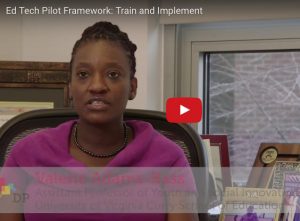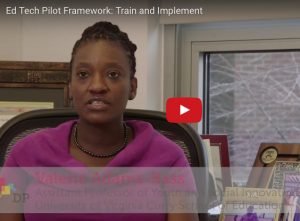By Valerie N. Adams-Bass, PhD
Valerie N. Adams-Bass is an Assistant Professor of the Youth and Social Innovations (YSI) program in the Curry School of Education and a Youth-Nex Faculty Affiliate, at the University of Virginia.
Educational Technology, Ed-Tech is garnering considerable attention as public school districts increasingly adopt and integrate technology into day-to-day instruction. In 2015, I worked as a research fellow with the University of California Davis School of Education on the Digital Promise Pilot to Purchase Project.
Considered a “short-cycle” research project, we worked at a rapid pace for the first half of the year to learn as much as we could from six districts that ranged in size from 1,200-to-96,000 students about how they pilot and make purchasing decisions about ed-tech products. To collect data, I touched down in 4 time zones and visited 4 states; Alabama, California, Idaho, Pennsylvania and the District of Columbia. After a demanding travel schedule, I wrapped up my data collection and headed home.
Many of our findings were published in Pilot-to-Purchase, Piloting Ed-tech Products in k-12 Public Schools report and we created a “tool kit” of resources that are the result of recommendations included in the report. In steps two, three and four of the toolkit I discuss planning, training and implementation and data collection, all important components of piloting ed-tech tools. You’ll find videos discussing these steps throughout this blog, courtesy of DigitalPromise.org.
Adams-Bass Video One:
From Digital Promise.org
Planning
When planning a pilot, districts must clearly articulate what they are trying to accomplish and how they will collect evidence to make an informed decision. Pilots produce the most useful results when everyone involved can answer the question, “What does success look like?”

Sifting through the data was a full-time process from June through September. My colleagues and I learned quite a bit from the site visits with these districts. Given the length of the project, our findings were remarkable and will be helpful for districts that are planning to integrate education technology-learning resources into their school classrooms and district curriculum. Many of our findings were published in Pilot-to-Purchase, Piloting Ed-tech Products in k-12 Public Schools report and we created a “tool kit” of resources that are the result of recommendations included in the report.
As a researcher, the secondary findings were of most interest to me. My primary focus as a researcher revolves around racial inequities and providing equitable experiences for all children, especially for African-American children and youth. One of the findings I find worth further discussion and investigation is detailed below.
- Districts with less ethnic/racial diversity were more likely to adopt a variety of ed-tech tools. Tools in these districts ranged from robotics, to computer coding courses for students as early as Kindergarten. These districts were also more creative with finding resources that were high quality and low cost. For example, one district, introduced Scratch a FREE (yes FREE) block coding software program that is supported and created by a Michigan Institute of Technology MIT team as an afterschool option for female students. Within a year, the program was integrated into the school day schedule and now serves as the foundation for advance coding courses for elementary and intermediary school students. By dedicating personnel resources to identifying low-cost or no cost products this district is able to divert budgetary dollars to other resources for the students.
This district also invests in software programs that improve Lexicon scores and other examination benchmarks that are all too familiar and correlated with the No Child Left Behind (NCLB) legislation, but they also think creatively and provide opportunities for their students, all students, not just the high achievers, to think and participate in creative learning in the classroom. I did not observe or hear about similar experiences in the more ethnically diversified districts.
Adams-Bass Video Two:
From Digital Promise.org
Train & Implement
Before the pilot begins, allow time to establish student accounts, orient educators to the tool’s features, and provide information about troubleshooting and support services. To encourage consistent implementation, identify a pilot coordinator to conduct weekly or bi-weekly check-ins with educators to gather data and encourage use.

A second district, located in a rural community with considerably less economic resources than the district described above, had a similar approach. The ed-tech tools this district adopted included a menu of options that were designed to help students to learn course content, to improve standardized test scores and/or to explore career opportunities through offering courses in coding to ALL students. As I noted, Scratch is a free, research-based ed-tech tool that comes with support for teachers, students and parents. I wonder, is the resistance for adopting and integrating creative learning opportunities colored by biases about student behavior, ability and achievement?
I have had conversations with urban public school administrators, both in traditional public and charter schools, about how best to connect with urban ethnically/racially diverse students. These schools are often full of African-American, Latino/a and Asian students who often demonstrate lower academic performance coupled with multiple at-home challenges. Frequently these discussions revolved around remedial efforts to improve academic performance. With one exception, conversations about creative learning options for all students are often met with resistance or discussions about budgetary constraints.
While I acknowledge the challenges many students in these districts have are steep and districts are often without enough resources, the track record of student expulsion, suspension and detention to manage behavior results in students losing more learning time and becoming further disengaged. Since NCLB afterschool programs such as 21stCCLC are often tailored to improving test scores through wrote learning or programs that are offer repetition type drills. Few afterschool sites offer more dynamic and engaging learning strategies that have been proven to support learning. At a minimum, this approach puts students at a competitive disadvantage.
Considering that many of the students in today’s generation have grown up with computers all around them and that African Americans are one the fastest growing adopters of android platform smart phones, introducing Scratch or another similar program to students seems like a smart investment. Sixty three percent of African American youth surveyed for the recently released The Digital Lives of African American Tweens, Teens, and Parents: Innovating and Learning with Technology reported daily use of computers. Ninety percent reported weekly usage but only 13% responded that they had been involved or introduced to coding.
Adams-Bass Video Three:
From Digital Promise.org
Collect Data
The ed-tech pilot size dictates the types and amount of data needed from participants. Consider gathering information from educators, leaders, students, and the product itself to best understand user experiences and learning outcomes. Review academic calendars and testing schedules, so students and teachers are not overburdened by the data collection process.
Students who learn to code learn not just how to use a computer-operated product (car sensors, drones, cell-phone, PlayStation), but how to create products. As coders they have the opportunity to think critically and become makers, not just consumers and regular opportunities to make real-world practical connections that just might help them to connect the dots to classroom learning. With what we now know about the digital lives of African American youth, the digital divide and what we know about the importance of developing critical thinking skills, why not Scratch?


